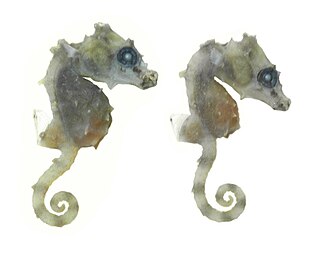Pseudophilautus maia is an extinct species of Sri Lankan shrub frogs described in 2007 from a single female museum specimen collected around 1860. It is housed at the Natural History Museum, London. It was named Top 4 New Species of 2007 by Arizona State University's International Institute for Species Exploration.
Opisthostoma vermiculum is a species of minute land snail with an operculum, a terrestrial gastropod mollusk or micromollusk in the family Diplommatinidae. The shell possesses four different coiling axes; the most for any known living gastropod. This member of the Diplommatinidae family is endemic to Malaysia. Its natural habitat is tropical limestone outcrops.

Satomi's pygmy seahorse is the smallest known seahorse in the world with an average length of 13.8 millimetres (0.54 in) and an approximate height of 11.5 millimetres (0.45 in).
The International Institute for Species Exploration (IISE) is a research institute located in Syracuse, New York. Its mission is to improve taxonomical exploration and the cataloging of new species of flora and fauna. Since 2008, IISE has published a yearly "Top 10" of the most unusual or unique biota newly identified in the previous year, with the aim of drawing attention to the work done in taxonomy across the world over the previous year.

Paedophryne amauensis is a species of microhylid frog endemic to eastern Papua New Guinea. At 7.7 mm (0.30 in) in snout-to-vent length, it is considered the world's smallest known vertebrate.
Crurifarcimen is a monotypic genus of millipedes containing the single species Crurifarcimen vagans. Its common name is wandering leg sausage. This millipede is endemic to Tanzania, where it is known only from the Usambara Mountains. It was formally described in 2011 and placed in a newly erected genus of its own. It was declared one of the world's top 10 new species of 2012 by Arizona State University's International Institute for Species Exploration.
Microbacterium dextranolyticum is a bacterium of the family Microbacteriaceae.
Microbacterium aquimaris is a Gram-positive, non-spore-forming and non-motile bacterium from the genus Microbacterium which has been isolated from seawater from Jeju in Korea. the major menaquinones of Microbacterium aquimaris are MK-11, MK-12 and MK-10.
Microbacterium aurantiacum is a bacterium from the genus Microbacterium which has been isolated from sewage.
Microbacterium barkeri is a bacterium from the genus Microbacterium which has been isolated from domestic sewage and from smear from a cheeses. Microbacterium barkeri has the ability to degrade polyvinyl alcohol.
Microbacterium binotii is a Gram-positive, rod-shaped and non-spore-forming bacterium from the genus Microbacterium which has been isolated from human blood from Foch Hospital in Suresnes, France.
Microbacterium chocolatum is a bacterium from the genus Microbacterium.
Microbacterium halophilum is a bacterium from the genus Microbacterium.<
Microbacterium hominis is a bacterium from the genus Microbacterium which has been isolated from lung aspirate.
Microbacterium invictum is a Gram-positive and facultatively aerobic bacterium from the genus Microbacterium which has been isolated from compost in Portugal.
Microbacterium kitamiense is a heterotrophic, strictly aerobic, mesophilic and non-motile bacterium from the genus Microbacterium which has been isolated from waste water from a sugar-beet factory in Kitami in Japan. Microbacterium kitamiense produces polysaccharide. Microbacterium kitamiense has a high GC-content.
Microbacterium kribbense is a Gram-positive and rod-shaped bacterium from the genus Microbacterium which has been isolated from soil from the Bigeum Island in Korea.
Microbacterium paraoxydans is a Gram-positive bacterium from the genus Microbacterium which was first isolated from the fish Nile tilapia in Mexico. This bacterium can cause disease in fish. Microbacterium paraoxydans metabolize (RS)-mandelonitrile to (R)-(-)mandelic acid. Microbacterium paraoxydans is a plant growth-promoting bacteria.
Microbacterium pseudoresistens is a Gram-positive and rod-shaped bacterium from the genus Microbacterium which has been isolated from the fungus Agaricus blazei in Taiwan.

Microbacterium virus MuffinTheCat is a species of bacteriophage in the family Tectiviridae. It was collected and identified by Darcy Reimer on 1 October 2019. It is part of the Microbacterium testaceum NRRL B-24232 viral strand and the GE viral cluster. Microbacterium of the Microbacterium testaceum species serve as natural hosts. Microbacterium virus MuffinTheCat is morphologically almost indistinguishable from its sibling species in the Tectiviridae family, but it along with its sibling species in the GE cluster are different enough from other Tectiviridae members that the GE cluster may soon be identified as a new genus. Microbacterium virus MuffinTheCat is identified from other GE cluster members by its genome differences.


